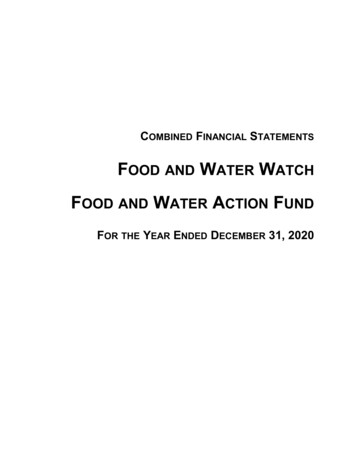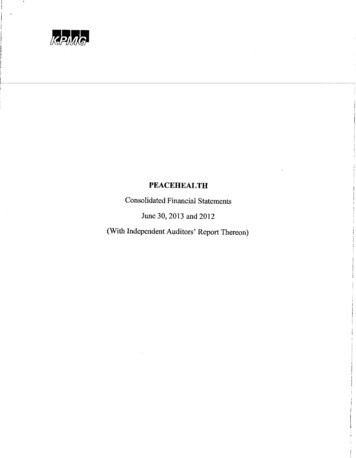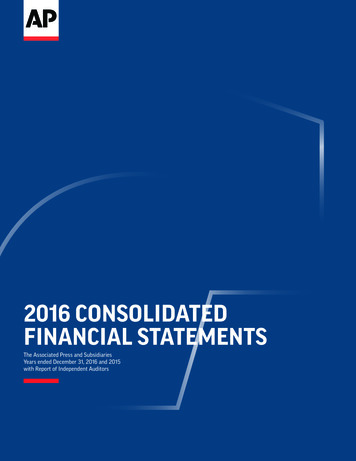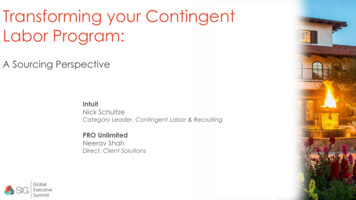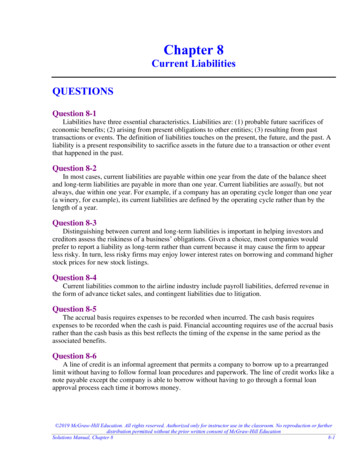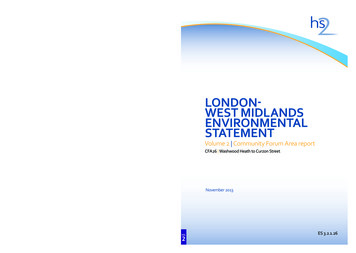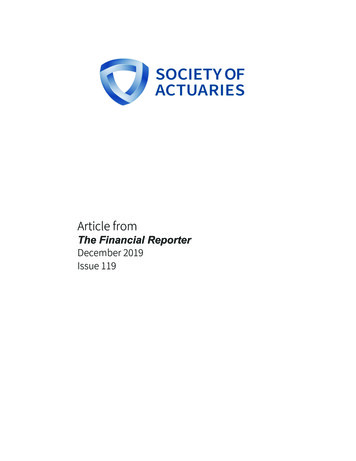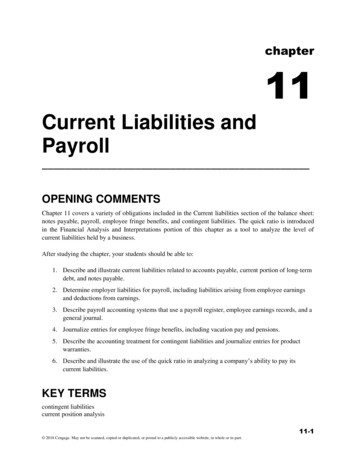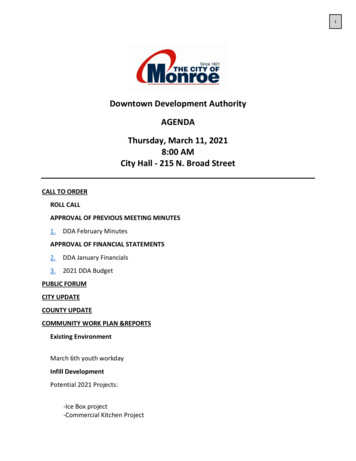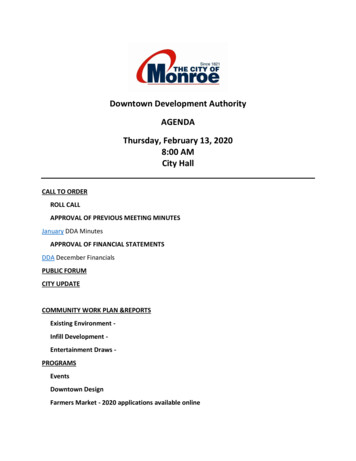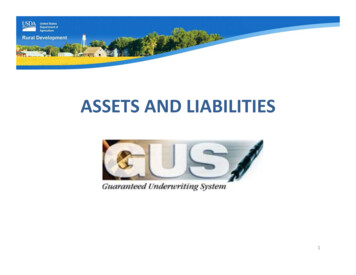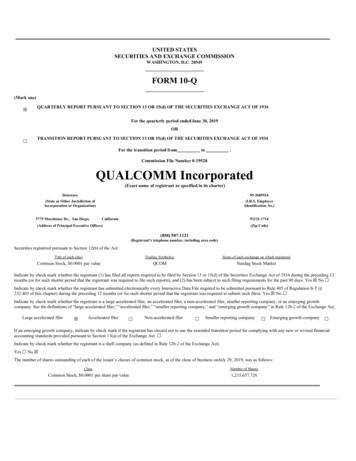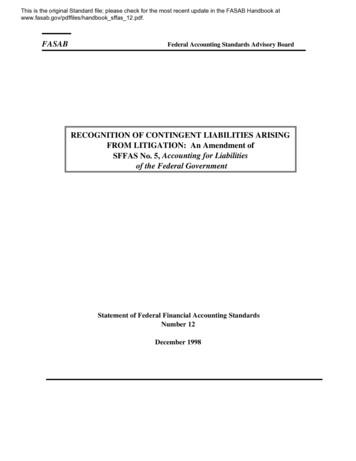
Transcription
This is the original Standard file; please check for the most recent update in the FASAB Handbook atwww.fasab.gov/pdffiles/handbook sffas 12.pdf.FASABFederal Accounting Standards Advisory BoardRECOGNITION OF CONTINGENT LIABILITIES ARISINGFROM LITIGATION: An Amendment ofSFFAS No. 5, Accounting for Liabilitiesof the Federal GovernmentStatement of Federal Financial Accounting StandardsNumber 12December 1998
This is the original Standard file; please check for the most recent update in the FASAB Handbook atwww.fasab.gov/pdffiles/handbook sffas 12.pdf.THE FEDERAL ACCOUNTING STANDARDS ADVISORY BOARDThe Federal Accounting Standards Advisory Board (FASAB, or “the Board”) was established inOctober 1990 by the Secretary of the Treasury, the Director of the Office of Management and Budget(OMB), and the Comptroller General. The nine-member Board was created to consider andrecommend accounting principles for the federal government.The Board communicates its recommendations by publishing recommended accountingconcepts and standards after considering the financial and budgetary information needs ofcongressional oversight groups, executive agencies, and other users of federal financialinformation. The Board also considers comments from the public on its proposedrecommendations, which are published for comment as "exposure drafts." After consideringoral and written comments, the standards may be recommended by the Board. The Board’ssponsors then decide whether to adopt the recommendations. If adopted, the standard ispublished by the OMB and the General Accounting Office and become effective.The following documents related to the establishment and mission of the Board are availablefrom the FASAB:(1)the "Memorandum of Understanding among the General Accounting Office, theDepartment of the Treasury, and the Office of Management and Budget on FederalGovernment Accounting Standards and a Federal Accounting Standards AdvisoryBoard"(2) the "Mission Statement of the Federal Accounting Standards Advisory Board"Federal Accounting Standards Advisory BoardAccounting for Liabilities of the Federal GovernmentDecember 1998
This is the original Standard file; please check for the most recent update in the FASAB Handbook atwww.fasab.gov/pdffiles/handbook sffas 12.pdf.EXECUTIVE SUMMARYThis recommended accounting standard amends Statement of Federal Financial AccountingStandards Number 5, Accounting for Liabilities of the Federal Government (SFFAS No. 5). Itprovides an exception to the contingent liability standard for recognizing loss contingencies onmatters of pending or threatened litigation and unasserted claims.1For loss contingencies covered by the exception, a contingent liability would be recognized whena future outflow or other sacrifice of resources is “likely to occur,” a past event or exchangetransaction has occurred, and the future outflow or sacrifice of resources is measurable. Beforethe amendment, SFFAS No. 5 called for recognition when an outflow is "more likely than not."2In addition to recognition, disclosure would be required for loss contingencies on matters ofpending or threatened litigation and unasserted claims if it is at least reasonably possible that aloss or an additional loss may have been incurred. The amendment does not affect recognition ofother types of contingencies.1The term “recognize” means the formal recording or incorporating of an item into the financial statements of an entity as an asset, liability,revenue, expense, etc. See FASAB Consolidated Glossary.2The term “disclosure” means the reporting of information in notes or narrative regarded as an integral part of the basic financial statement. SeeFASAB Consolidated Glossary.Federal Accounting Standards Advisory BoardAccounting for Liabilities of the Federal GovernmentDecember 1998
This is the original Standard file; please check for the most recent update in the FASAB Handbook atwww.fasab.gov/pdffiles/handbook sffas 12.pdf.TABLE OF CONTENTSPURPOSE . 1SCOPE . 1BACKGROUND . 1MATERIALITY . 2EFFECTIVE DATE. 2ACCOUNTING STANDARD . 3APPENDIX A: BASIS FOR CONCLUSIONS . 4APPENDIX B: Selected Section from Statement of Financial Accounting Standards No.5, Accounting for Contingencies. . 6APPENDIX C: Selected Sections of Statement of Federal Financial Accounting StandardsNo. 5, Accounting for Liabilities of the Federal Government. . 7Federal Accounting Standards Advisory BoardAccounting for Liabilities of the Federal GovernmentDecember 1998
This is the original Standard file; please check for the most recent update in the FASAB Handbook atwww.fasab.gov/pdffiles/handbook sffas 12.pdf.INTRODUCTION1IntroductionPURPOSE1.This Statement amends Statement of Federal Financial Accounting StandardsNumber 5 (SFFAS No. 5), Accounting for Liabilities of the Federal Government,to provide an exception to the contingent liability standard for matters of pendingor threatened litigation and unasserted claims. The proposed amendment wouldaffect accounting for contingencies under SFFAS No. 5 by inserting an exceptionto the definition of “probable” and to the recognition criteria in SFFAS No. 5 (seecurrent paragraphs 33, 36, and 38 of that standard in Appendix C).2.This standard applies to evaluations and accounting recognition and disclosure ofthe future outcome of litigation.3.The Federal Accounting Standards Advisory Board (FASAB) was asked to clarifythe application of the standard for recognizing loss contingencies for pending orthreatened litigation and unasserted claims. SFFAS No. 5 provides the definitionfor "liability" and establishes specific standards for five liability categories,including contingencies.4.SFFAS No. 5 defines a contingency as an existing condition, situation, or set of3circumstances involving uncertainty as to possible gain or loss. SFFAS No. 5requires a liability to be recognized for loss contingencies when a past event orexchange transaction makes a future outflow of resources probable and4measurable. It defines "probable" as that which can reasonably be expected orbelieved to be more likely than not on the basis of available evidence or logic but5which is neither certain nor proven.5.SFFAS No. 5 uses the same general framework for evaluating loss contingenciesas Financial Accounting Standards Board (FASB) Statement of FinancialSCOPEBACKGROUND3SFFAS No. 5, par. 35, and also in Appendix C.4SFFAS No.5, par. 36.5SFFAS No. 5, par. 33 and also see SFFAS No. 5’s Glossary.Federal Accounting Standards Advisory BoardAccounting for Liabilities of the Federal GovernmentDecember 1998
This is the original Standard file; please check for the most recent update in the FASAB Handbook atwww.fasab.gov/pdffiles/handbook sffas 12.pdf.INTRODUCTION2Accounting Standards No. 5, Accounting for Contingencies (SFAS No. 5).Contingencies can be "probable," "reasonably possible," or "remote;" and, basedon that, are recognized on the balance sheet, disclosed in footnotes, or notmentioned in the financial statements, respectively. However, SFAS No. 5 defines6"probable" as "likely to occur" instead of "more likely than not."6.Some auditors have expressed reservations about their ability under Statement ofAuditing Standards 12 (SAS 12) to express an unqualified opinion on the entity'sfinancial statements without a legal representation letter that refers to theSFFAS No. 5 standard. Lawyers have expressed serious objection to thedefinition of probable (“more likely than not”) contained in SFFAS No. 5. Theystate that a lawyer’s prediction of failure under the SFFAS No. 5 definition of“probable” (“more likely than not”), and the recording of a liability to reflect thatjudgment, could be used as an admission against interest, thereby jeopardizing thegovernment’s ability to fairly defend the public interest. Similarly, they furtherstate that a lawyer’s response to an auditor’s request for information on matterswhere an unfavorable outcome is more likely than not could result in thedisclosure of information protected by the lawyer-client privilege, disadvantagingthe government in any dispute, and violating the American Bar Association’sCode of Professional Responsibility.7.The Board believes that this amendment clarifies the standard for contingenciesinvolving pending or threatened litigation and unasserted claims and will facilitatecommunication among auditors, lawyers, those who prepare financial statements,and those who use the financial statements.8.The provisions of this statement need not be applied to immaterial items.9.This standard is effective for reports issued subsequent to the date of thisstatement for reporting periods beginning after September 30, 1997.MATERIALITYEFFECTIVE DATE6SFAS No. 5, par. 3.Federal Accounting Standards Advisory BoardAccounting for Liabilities of the Federal GovernmentDecember 1998
This is the original Standard file; please check for the most recent update in the FASAB Handbook atwww.fasab.gov/pdffiles/handbook sffas 12.pdf.ACCOUNTING STANDARD3Accounting Standard10. Paragraph 33 of SFFAS No. 5 is amended by adding "with the exception ofpending or threatened litigation and unasserted claims" at the end of the firstsentence. Paragraph 33 is further amended by adding the following footnote tothe first sentence:The concept of probability is imprecise and difficult to apply with respect tomost legal matters. The "more likely than not" phrase suggests greaterprecision than is attainable when assessing the outcome of matters in litigation.Accordingly, in the context of assessing the outcome of matters of pending orthreatened litigation and unasserted claims, and recognizing an associatedliability, "probable" refers to that which is likely, not to that which is morelikely than not. Note that the remaining two criteria for recognizing a liability-that is, a past event or exchange transaction has occurred and the futureoutflow or sacrifice of resources is measurable--also must be met beforerecognizing a contingent liability in matters involving litigation.11. Other conforming changes to SFFAS No. 5 are:The first bullet of paragraph 36 is changed as follows: “Probable: The futureconfirming event or events are more likely than not to occur, with theexception of pending or threatened litigation and unasserted claims. Forpending or threatened litigation and unasserted claims, the future confirmingevent or events are likely to occur.”Paragraph 38 of SFFAS No. 5 is amended by replacing “more likely than not”in the second bullet with “likely.”Federal Accounting Standards Advisory BoardAccounting for Liabilities of the Federal GovernmentDecember 1998
This is the original Standard file; please check for the most recent update in the FASAB Handbook atwww.fasab.gov/pdffiles/handbook sffas 12.pdf.APPENDIX A: BASIS FOR CONCLUSIONS4Appendix A: Basis for Conclusions12.In their capacity as legal counsel to federal agencies, lawyers should evaluatethe outcome of matters of pending or threatened litigation and unassertedclaims, and estimate any losses therefrom, in accordance with the AmericanBar Association’s Statement of Policy Regarding Lawyer’s Responses toAuditors’ Requests for Information. Attorneys note that neither the outcomeof litigation nor any loss resulting therefrom can be assessed “in any way that iscomparable to a statistically or empirically determined concept of probability"(see Auditor's Letter Handbook, American Bar Association, page 18). The"more likely than not" phrase suggests greater precision than is attainable whenassessing the outcome of matters in litigation.13.Accordingly, in the context of such cases the standard refers simply to thatwhich is "likely." In this context, therefore, "likely to occur" is used in federalaccounting standards in the same way that it is used in Statement of FinancialAccounting Standards No. 5, Accounting for Contingencies, published by theFinancial Accounting Standards Board in 1975.14.The Board believes that this amendment will serve the objectives of financialreporting because it will facilitate communications among auditors, lawyers,those who prepare financial statements, and those who use the statements.15.The Board published an exposure draft of this standard on October 30, 1998,and received thirty responses, six of which had no comment. Of the 24 whocommented, 22 concurred with the proposed standard. (Two responses werepositive but could not be characterized as concurrence.) No respondentobjected to the amendment. Five respondents suggested broadening the scopeof the amendment to apply “likely to occur” to all contingent liabilities.16.Although some respondents suggested broadening the application, the Boardconcluded that the amendment should be limited to contingent liabilitiesresulting from litigation. Most respondents concurred with this approach. TheBoard plans additional research on this subject in 1999.17.The Board has made minor changes to the proposal published as an exposuredraft. Several respondents suggested minor changes in wording and/ornotations in paragraphs 33 and 36 in addition to or instead of paragraph 38 toFederal Accounting Standards Advisory BoardAccounting for Liabilities of theFederal GovernmentDecember 1998
This is the original Standard file; please check for the most recent update in the FASAB Handbook atwww.fasab.gov/pdffiles/handbook sffas 12.pdf.APPENDIX A: BASIS FOR CONCLUSIONS5clarify the amendment. The Board has adopted most of these suggestions.18.The Board makes this recommendation with a vote of nine members approvingissuance and no members opposing issuance.Federal Accounting Standards Advisory BoardAccounting for Liabilities of theFederal GovernmentDecember 1998
This is the original Standard file; please check for the most recent update in the FASAB Handbook atwww.fasab.gov/pdffiles/handbook sffas 12.pdf.APPENDIX B: SFAS No. 56Appendix B: Selected Section from Statement of Financial Accounting Standards No. 5, Accountingfor Contingencies.1. For the purposes of this Statement, a contingency is defined as an existingcondition, situation, or set of circumstances involving uncertainty as to possible gain(hereinafter a "gain contingency") or loss (hereinafter a "loss contingency") to anenterprise that will ultimately be resolved when one or more future events occur or failto occur. Resolution of the uncertainty may confirm the acquisition of an asset or thereduction of a liability or the loss or impairment of an asset or the incurrence of aliability.* * *3. When a loss contingency exists, the likelihood that the future event or events willconfirm the loss or impairment of an asset or the incurrence of a liability can rangefrom probable to remote. This Statement uses the terms probable, reasonablypossible, and remote to identify three areas within that range, as follows:a.Probable. The future event or events are likely to occur.b. Reasonably possible. The chance of the future event or events occurring ismore than remote but less than likely.c. Remote. The chance of the future event or events occurring is slight.* * *8. An estimated loss from a loss contingency (as defined in paragraph 1) shall beaccrued by a charge to income if both of the following conditions are met:a. Information available prior to issuance of the financial statements indicates that itis probable that an asset had been impaired or a liability had been incurred at thedate of the financial statement. It is implicit in this condition that it must beprobable that one or more future events will occur confirming the fact of the loss.b. The amount of the loss can be reasonably estimated.Federal Accounting Standards Advisory BoardAccounting for Liabilities of the Federal GovernmentDecember 1998
This is the original Standard file; please check for the most recent update in the FASAB Handbook atwww.fasab.gov/pdffiles/handbook sffas 12.pdf.APPENDIX C: SFFAS No. 57Appendix C: Selected Sections of Statement of Federal Financial Accounting Standards No. 5,Accounting for Liabilities of the Federal Government (footnotes omitted).* * *33“Probable” refers to that which can reasonably be expected or is believed to be morelikely than not on the basis of available evidence or logic. The probability of a futureoutflow or other sacrifice of resources is assessed on the basis of current facts andcircumstances. These current facts and circumstances include the law that providesgeneral authority for federal entity operations and specific budget authority to fundprograms. If budget authority has not yet been provided, a future outflow or othersacrifice of resources might still meet the probability test if (1) it directly relates toongoing entity operations and (2) it is the type for which budget authority is routinelyprovided. Therefore, the definition applies both to liabilities covered by budgetaryresources and to liabilities not covered by budgetary resources.* * *CONTINGENCIES35A contingency is an existing condition, situation, or set of circumstances involvinguncertainty as to possible gain or loss to an entity. The uncertainty will ultimately beresolved when one or more future events occur or fail to occur. Resolution of theuncertainty may confirm a gain (i.e., acquisition of an asset or reduction of a liability)or a loss (i.e., loss or impairment of an asset or the incurrence of a liability).36This Statement does not deal with gain contingencies or measurement of contingenciesthat involve impairment of nonfinancial assets. When a loss contingency (i.e.,contingent liability) exists, the likelihood that the future event or events will confirmthe loss or the incidence of a liability can range from probable to remote. Theprobability classifications are as follows: Probable: The future confirming event or events are more likely than not to occur.Reasonably possible: The chances of the future confirming event or eventsoccurring is more than remote but less than probable.Remote: The chance of the future event or events occurring is slight.Federal Accounting Standards Advisory BoardAccounting for Liabilities of the Federal GovernmentDecember 1998
This is the original Standard file; please check for the most recent update in the FASAB Handbook atwww.fasab.gov/pdffiles/handbook sffas 12.pdf.APPENDIX C: SFFAS No. 5378The following are some examples of loss contingencies: collectibility of receivables,pending or threatened litigation, andpossible claims and assessments.CRITERIA FOR RECOGNITION OF A CONTINGENT LIABILITY38A contingent liability should be recognized when allof these three conditions are met: A past event or exchange transaction has occurred (e.g., a federal entity hasbreached a contract with a nonfederal entity). A future outflow or other sacrifice of resources is probable (e.g., thenonfederal entity has filed a legal claim against a federal entity for breach ofcontract and the federal entity’s management believes the claim is more likelythan not to be settled in favor of the claimant). The future outflow of resources is measurable (e.g., the federal entity’smanagement determines an estimated settlement amount).39The estimated liability may be a specific amount or a range of amounts. If someamount within the range is a better estimate than any other amount within the range,that amount is recognized. If no amount within the range is a better estimate than anyother amount, the minimum amount in the range is recognized and the range and adescription of the nature of the contingency should be disclosed.CRITERIA FOR DISCLOSURE OF A CONTINGENT LIABILITY40A contingent liability should be disclosed if any of the conditions for liabilityrecognition are not met and there is at least a reasonable possibility that a loss or anadditional loss may have been incurred. “Disclosure” in this context refers toreporting information in notes regarded as an integral part of the basic financialinformation.41Disclosure should include the nature of the contingency and an estimate of the possibleliability, an estimate of the range of the possible liability, or a statement that such anestimate cannot be made.Federal Accounting Standards Advisory BoardAccounting for Liabilities of the Federal GovernmentDecember 1998
This is the original Standard file; please check for the most recent update in the FASAB Handbook atwww.fasab.gov/pdffiles/handbook sffas 12.pdf.APPENDIX C: SFFAS No. 5429In some cases, contingencies may be identified but the degree of uncertainty is so greatthat no reporting (i.e., recognition or disclosure) is necessary in the general purposefederal financial reports. Specifically, contingencies classified as remote need not bereported in general purpose federal financial reports, though law may require suchdisclosures in special purpose reports. If information about remote contingencies orrelated to remote contingencies is included in general purpose federal financial reports(e.g., the total face amount of insurance and guarantees in force), it should be labeledin such a way to avoid the misleading inference that there is more than a remotechance of a loss of that amount.Federal Accounting Standards Advisory BoardAccounting for Liabilities of the Federal GovernmentDecember 1998
This is the original Standard file; please check for the most recent update in the FASAB Handbook atwww.fasab.gov/pdffiles/handbook sffas 12.pdf.FASAB Board MembersDavid Mosso, ChairmanLinda BlessingJames L. BlumPhilip T. CalderDonald H. ChapinNorwood JacksonDonald HammondJames E. ReidNelson ToyeFASAB StaffWendy M. Comes, Executive DirectorProject Staff:Richard FontenroseFederal Accounting Standards Advisory Board441 G Street, NWRoom 3B18Washington, DC 20548Telephone (202) 512-7350Fax (202) 512-7366Federal Accounting Standards Advisory BoardAccounting for Liabilities of the Federal GovernmentDecember 1998
3. The Federal Accounting Standards Advisory Board (FASAB) was asked to clarify the application of the standard for recognizing loss contingencies for pending or threatened litigation and unasserted claims. SFFAS No. 5 provides the definition for "liability" and establishes specific standards for five liability categories, including .
